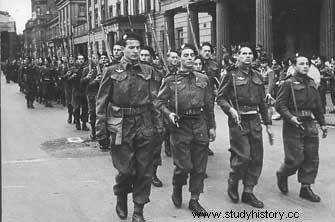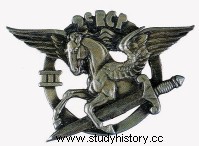
The 2nd Parachute Chasseur Regiment is one of the most decorated French units of World War II. It is the only land unit to have obtained the fourragère rouge during this conflict with six citations at the order of the army1, the submarine Casabianca also accumulating 6 citations at the order of the army and therefore the same fodder.
Known in the British army as the 4th SAS, this unit will be the subject of the film Le Bataillon du ciel directed in 1947 by Alexander Esway based on the book by Joseph Kessel.
Creation and different denominations
July 1, 1943:creation of the 1st Air Infantry Battalion
November 1, 1943:4th Air Infantry Battalion
April 1, 1944:renamed 4th SAS Regiment or 2nd Parachute Chasseur Regiment for the French
September 30, 1946:dissolution of the regiment2.
Constitution of the unit
The 1st Air Infantry Battalion (1st BIA) was formed on July 1, 1943 at Old Dean Camp in Camberley from volunteers and the 1st and 2nd Air Infantry Companies3, the creation of which dates back to September 15, 19404.
The battalion, integrated into the Free French Air Force, was entrusted to Commander Fourcaud. It then had 398 men divided into four companies.
The unit was renamed 4th Air Infantry Battalion on November 1, 1943 and was placed under the orders of Commander Bourgoin, a penguin who had his right arm amputated in February 1943 during a reconnaissance mission in Tunisia. The 4th BIA is joined to the 3rd BIA of Commander Chateau Jobert within a demi-brigade commanded by Lieutenant Colonel Durand.
It should be noted that many French volunteers will undergo parachute training at the Airborne Troops School of the 1st Independent Polish Parachute Brigade in Largo, Scotland, where 244 Polish patents will be issued5.
In April 1944, the BIA, which joined their British and Belgian counterparts in December 1943 within the SAS brigade of the Army air corps, took the name of regiments:the 3rd and 4th BIA became respectively the 3rd and 4th SAS Regiments for the British and the 3rd and 2nd Parachute Chasseur Regiments for the French.
Operations in Brittany
On the night of June 5 to 6, 1944, four SAS sticks (36 men) respectively under the orders of Lieutenants Marienne, Déplante, Botella and Deschamps, boarded two RAF Short Stirling four-engined aircraft bound for Brittany. The first two teams parachuted into the Plumelec sector, 15 km from the Maquis de Saint-Marcel, Morbihan. The other two in the forest of Duault in the Côtes-d'Armor. Their mission is to establish guerrilla bases codenamed Operation Dingson and Operation Samwest respectively.
During the months of June and July, the SAS paratroopers lead the life of woodsmen. Sometimes they brutally attack and retreat, sometimes they hide to better intervene when a favorable opportunity arises. The enemy and the militiamen are at the height of exasperation. They torture and kill anyone who is suspicious. On July 12 at dawn, acting by trickery, a group of Feldgendarmes accompanied by militiamen infiltrated as far as Lieutenant Marienne's command post in Kerihuel, Plumelec where 18 men:paratroopers, guerrillas and farmers, were shot down with machine guns then horribly mutilated. Finally, when on August 3, General Patton's US tanks reached Rennes, they put an end to the heinous massacres. The 4th SAS regiment (or 2nd RCP), lost (killed, wounded, prisoners) 23 officers and 195 men out of 50 officers and 500 men (77 died for the Liberation of Brittany). Their mission has been fulfilled beyond all hope.
The latest operations
SAS combat sometimes has unforeseen conclusions. At Montceau-les-Mines, a group of paratroopers and a handful of FFIs made the enemy forces, vastly superior in number, believe that the strength of a division surrounded them. Immediately, they recover 500 prisoners, tanks and guns. By the end of the campaign, the 3e RCP had lost 80 of its own out of a strength of 400 men. He has to his credit 5,500 enemy put out of action, about 1,400 prisoners and 382 various vehicles.
At Christmas 1944, SAS paratroopers operated in the Ardennes, as part of the counter-offensive of Operation Von Runstedt. The men of the 4th SAS regiment (2nd RCP) hunt down the Skorzeny commandos. On November 11, 1944 in Paris, the survivors of the 2nd RCP received, in homage from King George VI, the right to wear the amaranth beret.
On April 7, 1945, the two RCPs (770 men) were parachuted into the Netherlands (Operation Amherst).
After the war
On August 1, 1945, the 3rd and 4th SAS regiments, for the French 2nd and 3rd RCP, were transferred to the army. They will soon merge to form a single 2nd RCP which will settle in Tarbes. On October 2, 1945, British General Calvert, commander of the SAS brigade, visited them and gave them their pennants as well as a Napoleon hat and a Wellington hat, a sign of friendship and fraternity in arms.
The 2nd RCP was dissolved on September 30, 1946, its numbers were divided between the 1st RCP and the 1st RICAP while its flag was entrusted to the SAS demi-brigade of Indochina, which became the 1st RPIMa and kept the decorations of the 2nd RCP .

Currency
Who dares wins in English Qui dares wins
Badge
Flag
It bears, sewn in gold letters in its folds, the following inscriptions
Crete 1942
Libya 1942
South Tunisia 1943
France 1944-1945
Holland 1945
Decorations
Liberation Cross7
War Cross 1939-1945 with 6 palms
Belgian War Cross
Dutch War Cross
Bronze Star Medal (US)
Leaders
Captain Coulet:1942 (1st BIA)
Captain Lambert:1943 (1st BIA)
Battalion Commander Fourcaud:July 1943 (1st BIA)
Commander Bourgoin:November 1943 (4th BIA)
Commander Puech-Samson:November (2nd RCP)
Lieutenant-colonel de Bollardière:August 1, 1945 (2e RCP)
Colonel Reynier:1945 (2e RCP)
Personalities who served in the regiment
Lucien Neuwirth:French deputy, he is considered the "father of the pill" with his bill on birth control adopted in 1967. Engaged in the 4th Air Infantry Battalion in 1943, he fought in Brittany then was parachuted into Holland where he miraculously survived the firing squad.
